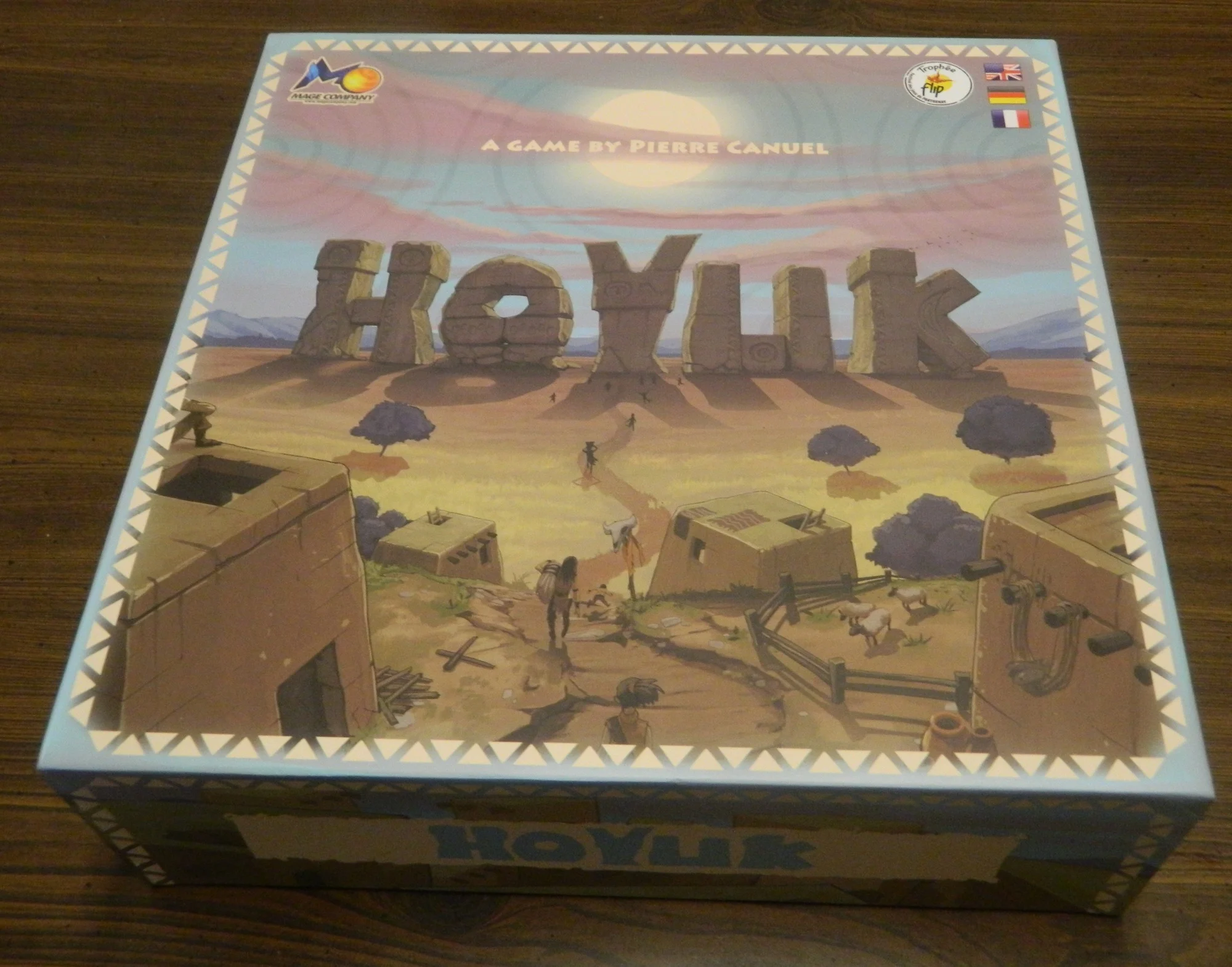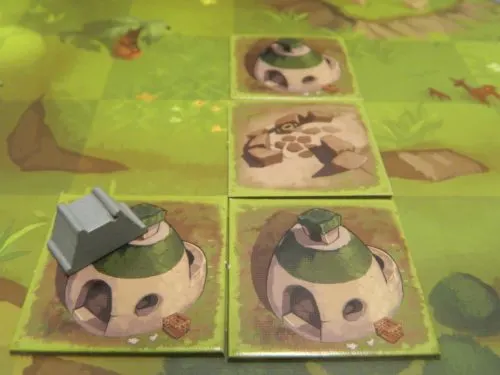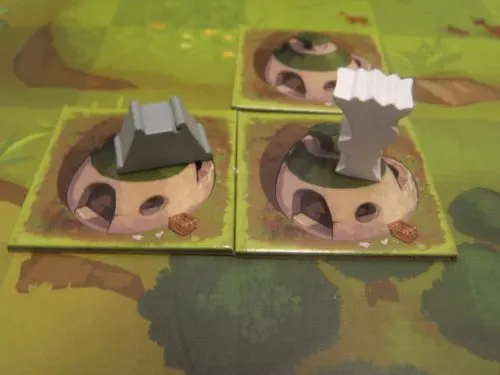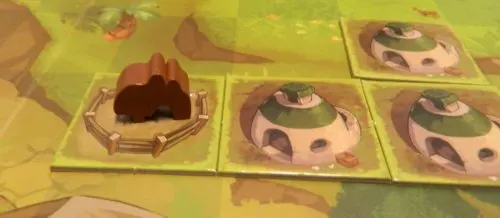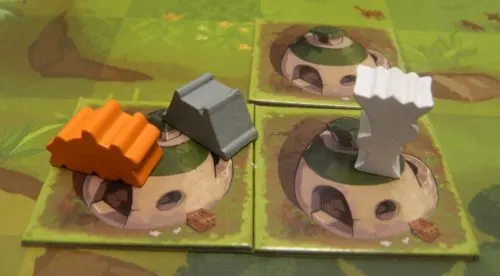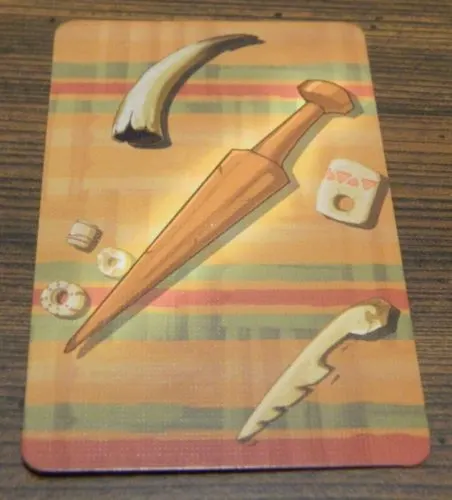Back in 2006 Hoyuk was created as a print and play game. Hoyuk remained a print and play game until 2014 when a retail version of the game was released by Mage Company. In Hoyuk you control a clan during the Neolithic period almost 10,000 years ago. Clans are beginning to form communities with other clans for safety and prosperity. No clan is satisfied with having less then another clan though so you must compete to have the most successful clan. While it is not a perfect game, Hoyuk does a good job of mixing easy to learn mechanics with enough strategy to make a compelling game.
How to Play Hoyuk
Setup
Each player chooses a clan taking the houses of their color and putting their score marker on the zero spot on the gameboard. The game mode you choose will determine what pieces you will use in the game. Place ten aspect cards face up on each of the aspect spaces on the left side of the board. The rest of the components are put on their corresponding spots on the gameboard. To determine the starting player each player puts two of their house tiles in a pile and the owner of the house that is chosen becomes the first player.
Playing the Game
Hoyuk is a game that is played in rounds. Each round consists of four different phases that are as follows:
- Construction
- Catastrophe
- Drawing Aspect Cards
- Clean Up
The first player will perform each phase followed by the next player clockwise and so on. Once all of the players have completed the current phase, the players move onto the next phase. Once the fourth phase has ended the players will check whether the game has ended. Hoyuk can end under two circumstances:
- At least one player has played all of their house tiles.
- There are no valid places remaining to play a house tile on the board.
If neither of the end game conditions have been met a new round begins. The current first player chooses which player will be the first player in the next round.
Construction
During the construction phase players will get to add their house tiles and other pieces to the gameboard. Starting with the first player, one construction card is dealt face up to each player. The first player will get to use their card first followed by the player to their left. Once everyone has used their card, an additional card is dealt to each player. Once all of these cards have been used the construction phase ends. When you run out of construction cards you shuffle the used construction cards to form a new draw deck.
When you look at a construction card there will be three symbols/sets of symbols on the card. These three symbols will tell you what construction actions you can perform on your turn. If there is a group of symbols you get to choose one of the symbols to use.
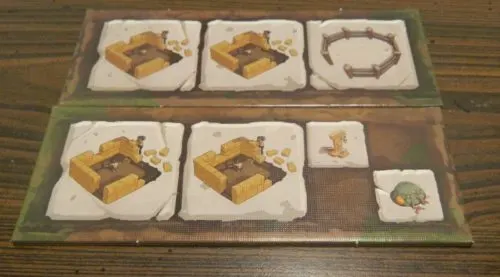
The top construction card allows a player to add two houses and a pen to the gameboard. The bottom card allows a player to add two houses and either a shrine or an oven.
Building Houses
Every construction card in Hoyuk has at least two house symbols on it. When you build a house you will place one of your house tiles out on the gameboard. When placing houses out on the board they must be placed on one of the squares on the board. You can choose from two different options when placing a house. First you can place a house by itself which will create a new block. A “block” in Hoyuk refers to all of the houses that are connected to one another by one or more sides (this includes houses played by other players).
The other option is to add to an existing block. If you don’t already have a house in the block you can add the tile anywhere in the block next to another house as long as you don’t break any of the other construction rules that follow. If you already have houses in the block though, you must play all future houses next to one of your other houses in the block. Your group of houses inside a block is called a “family”. A block should only have one family for each player unless a family gets broken up due to a house being destroyed.
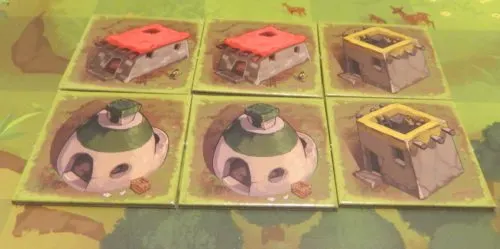
This is a block in Hoyuk. If the red, yellow, or green player want to add another tile to this block they will have to play it next to one of their own tiles.
When adding to a block you can never add a tile that would connect two different blocks together.
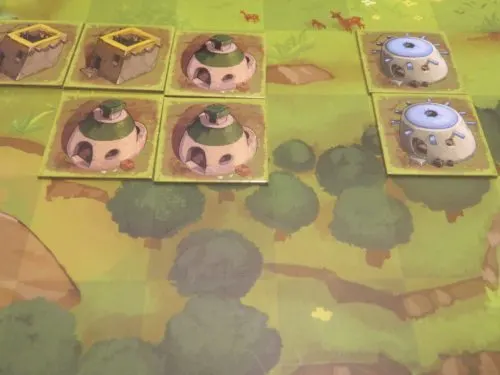
In this picture there are two blocks which include the yellow/green block and the blue block. At no time in the game can a player add a tile between the blue and green houses since that would combine two blocks into one block.
In addition to adding a new house to the board, a player can use one of their house tiles to add a second floor to a house. A player can only add a second floor to their own houses. If you would like to add a second story to a house that has a shrine, oven or villager; you must remove the oven, shrine or villager before adding the second floor. A shrine, oven or villager can be added to the second floor of a house at any time. A second floor can also only be added to a house that has at least one side that doesn’t have a tile next to it. After a second floor has been built, other houses can be built surrounding the second story house.
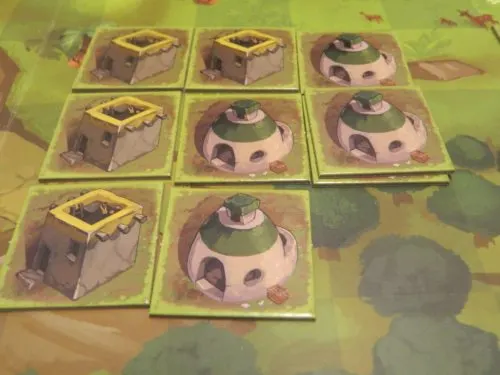
The green player has added a second story to their house on the right. The green player couldn’t add a second story to their house in the middle since it didn’t have a free space on any of its’ sides.
During the catastrophe phase some houses are likely to be destroyed. If a house is destroyed the tile is flipped to the other side. Once a house is ruined the space that it occupies is open to any player to build on. When a new house is played on the space, the ruined house is removed from the game. A catastrophe could impact a house that will separate a block into two sections. These two sections are still part of the same block.
Even though there is a destroyed house in the middle of this block, it is still only one block.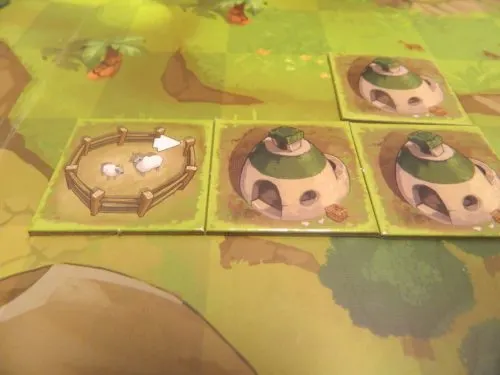
Building Pens
When you get a pen symbol you get to add a pen to one of your houses. The pen must be played next to one of your houses with the arrow on the tile pointing to the house that it belongs to. A pen can only be placed in an area where at least one of the pen’s sides doesn’t have a tile next to it.
Placing Shrines and Ovens
When you get a shrine or oven symbol you can place the corresponding piece into one of your houses. A shrine or oven can be placed in any house but no house can have both a shrine and oven.
Placing Cattle (Advanced Game)
Cattle are placed inside pens. Only one cattle can be placed in each pen.
Placing Villagers (Advanced Game)
Villagers are placed in houses. Only one villager can be placed in each house. A villager can share a house with an oven or shrine though.
Placing the Shaman
When you get the shaman symbol you can place the shaman on one of your houses. The shaman will protect all of the houses in that block from the next disaster that would otherwise impact that block.
Catastrophes
At the beginning of the catastrophe phase the first player draws the top catastrophe card. The catastrophe card is going to affect different blocks on the gameboard. Each catastrophe card features two sides. The left side indicates what block(s) will be affected while the right side indicates what will be destroyed/removed. If there are two symbols on the left side it will impact the block that has the most/largest while one symbol indicates the block with the fewest/smallest. If a catastrophe destroys half of something, you will get to round down. If you only have one of the item, you will lose it. If there are two or more blocks that the catastrophe would apply to, all of the blocks are affected. If the block that would have been impacted has the shaman in it, it is protected from the catastrophe. The shaman is removed from the block though.
A short description of each catastrophe is as follows:
Bad Season: Each player in the block with the least/most shrines lose one of their houses.
Drought: Each player in the smallest/largest block have to get rid of half of their cattle (advanced game).
Epidemic: Each player in the smallest/largest block have to get rid of half of their villagers (advanced game).
Earthquake: Each player in the smallest/largest block lose half of their houses.
Fire: Each player in the block with the least/most ovens lose half of their houses.
Flood: The shaman is moved back to the shaman area on the board (advanced game).
Locust Swarm: No aspect cards are rewarded to the smallest/largest block on the board.
Looters: Each player in the smallest/largest block loses half of their shrines.
Sacrifice: Each player in the block with the least/most pens loses one of their houses.
Tornado: Each player in the block with the least/most two story houses loses one of their houses.
Volcano: Each player in the smallest/largest block loses half of their pens.
Wolves: Each player in the smallest/largest block loses half of their ovens.
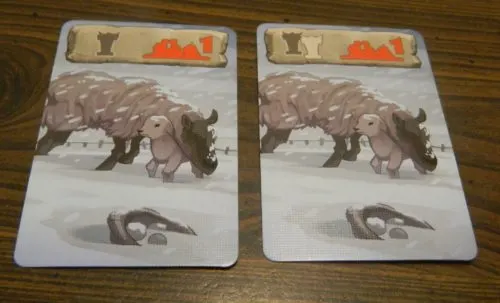
These are the two bad season cards. The card on the left applies to the block with the least shrines while the right card applies to the block with the most shrines.
When a catastrophe destroys a house the tile is flipped over to the ruined side. If the house had a second story it is removed from the game. If the house had a pen, shrine, oven, cattle or villager it is removed from the house and put back on the corresponding part of the board.
Drawing Aspect Cards
The aspect card round begins with the first player deciding which block will be analyzed first. The next player clockwise will get to chose the next block and so on. Every block that contains houses from at least two players will be analyzed.
When analyzing a block the players will determine who has the most in several different aspects. The player who wins an aspect will get to take the top card from the corresponding spot of the gameboard. If an aspect doesn’t apply to a block, no card is rewarded for that aspect. If there is a tie for an aspect, two story houses break the tie. Whichever player has the most of the element on/connected to two story houses breaks the tie. If two or more players are still tied, no player gets the card.
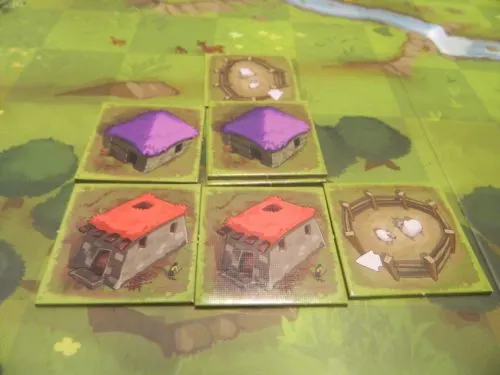
In this block both player have one pen. The purple player would break the tie though since they have their pen attached to a two story house.
The different categories that reward aspect cards are as follows:
- Shrines: The player with the most shrines in the block wins the card.
- Pens: The player with the most pens in the block wins the card.
- Ovens: The player with the most ovens in the block wins the card.
- House Height: The player with the most two story houses in the block wins the card (medium game).
- Number of Houses: The player with the most houses (two story houses count as one house) in the block wins the card (medium game).
- Number of Cattle: The player with the most cattle in a block wins the card (advanced game).
- Number of Villagers: The player that has the most villagers in a block wins the card (advanced game).
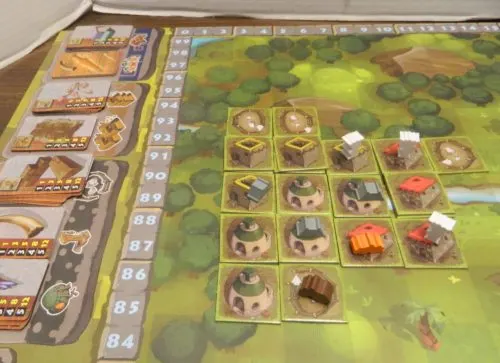
Aspect cards for this block will be handed out as follows:
Green will get the card for the most ovens since they have two while yellow has one.
Red will get the card for shrines for two shrines versus the one shrine for yellow.
Yellow will get the card for pens since they have two while the other players have one.
Green will get the card for largest family with five houses.
Yellow will get the card for most two story houses with two.
Red will get the card for the most villagers with one.
Finally green will get the card for the most cattle with one.
If at any time there are no cards left for one of the aspects, no player will receive cards for that aspect for the rest of the game.
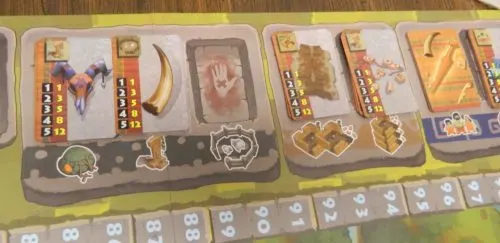
There are no cards left for the pen aspect. Players will no longer receive cards for having the most pens in a block.
Clean Up
After all of the blocks have been analyzed it is time to clean up for the next round. Each player (starting with the first player) will put all of the aspect cards that they played during the round onto one of the aspect piles on the side of the board. All of the player’s cards have to be added to the same aspect. A player is unable to add cards to an aspect that no longer has any cards. The cards that a player adds to an aspect are placed face up under the cards already on that aspect.
Players check whether one of the end game conditions have been met. If not, the first player chooses who will be the first player for the next round. A new round then begins.
Using Aspect Cards
After receiving aspect cards from the third phase you are able to use them to help yourself in the game. At the beginning of any of the four phases you can play cards starting with the first player. The number of cards that a player can play at the beginning of each phase is equal to the number of families they currently have on the board (three families, three cards).
The cards that have the unique backgrounds are treated as wild cards and can be used as any other card.
Aspect cards can be played in two different ways.
First a card can be played to add the element in the top left of the card to the gameboard. Each card played in this manner adds one of the associated item to the gameboard.

Any player can choose to play one of these cards for the symbol in the top left corner. After playing the card they will add the appropriate item to the gameboard.
The second way to play an aspect card is for victory points. By playing multiple cards with the same symbol in the top left corner you will score victory points. Depending on the number of cards that you play with the same symbol, you consult the chart on the card to see how many victory points you earn. The victory points you earn for playing cards in this manner are immediately added to your score.
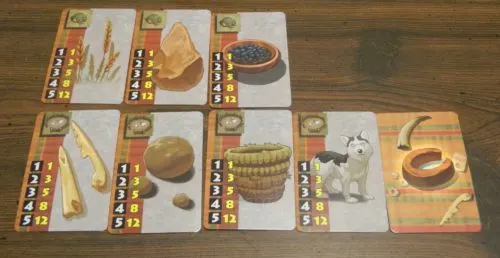
If a player played the top three cards they would receive five points. If they played the bottom five cards they would receive twelve points. If you were using the clan special abilities you would also be able to use your special ability.
Clan Powers
If you are playing the advanced game each tribe color has a special ability. This special ability can be used whenever a player plays five cards of the same symbol (scoring 12 points). The special abilities are as follows:
- Drers (Red): Destroy one house belonging to another player and any elements on that house. The house that you destroy has to be next to one of your own houses. You will then build one of your own houses on the spot of the house you destroyed.
- Sneerg (Green): Add one pen and cattle to one of your houses on the board.
- Lebu (Blue): Add one pen and villager to one of your houses on the board.
- Oleyli (Yellow): Take two elements (not houses) from any other player and use them however you want.
- Ruples (Purple): Add one house to the board and place the shaman on that house.
End of Game
The game ends when one player has either played all of their house tiles or there are no more valid positions where a house can be played. When this happens the rest of the round is completed and then final scoring is conducted. Final points are scored as follows:
- For each unused aspect card still in a player’s hand, they score one victory point.
- Each block on the board is analyzed to determine the largest family. The player with the most houses (two story houses only count as one house) has the largest family in the block. Two story houses act as tiebreakers. The player with the largest family in each block will receive one victory point per house.
- Each block is analyzed to determine which player has the most cattle. The player with the most cattle in each block earns one victory point for each cattle in the block (advanced game).
- Each block is analyzed to determine which player has the most villagers. The player with the most villagers in each block earns one victory point for each villager in the block (advanced game).
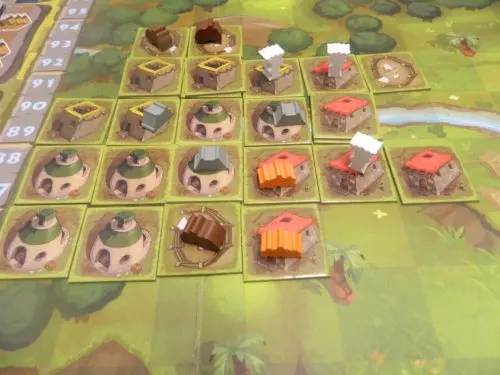
For this block the green player will score seven points for having the largest family (seven houses). The yellow player will score two points for having the most cattle (two cattle). The red player will score two points for having the most villagers (two villagers).
The player with the most victory points wins the game. If there is a tie, the player with the most two story houses breaks the tie. If there is still a tie, the tied players share the victory.
My Thoughts Hoyuk
When I first looked at Hoyuk I was actually kind of intimidated. The box is surprisingly large and then I looked at the instruction booklet. When I saw that the instructions were 20 pages long I was wondering how difficult the game was going to be. In my experience most games with a 20 page instruction booklet end up being pretty difficult/complicated. I have to say that Hoyuk’s initial appearance was deceiving though. While the instructions are long, the game itself is actually surprisingly easy to learn and play.
The main reason why Hoyuk’s rule book is so long is that the game has quite a few different mechanics. While there are quite a few mechanics, they are pretty easy to pick up. Most of the mechanics are pretty straightforward and a lot of them do a good job building off of one another. It might take a while to explain all of the different rules to new players but I don’t see them having a lot of issues with any of the rules. People who play a lot of designer games should have no problems while people who don’t play a lot of designer games may only have some small issues learning the game.
When I first started reading the rules for Hoyuk I was intrigued by the idea that the game had a basic, medium and advanced game. Most games only have one difficulty with some games having both a basic and advanced mode. It was interesting to see a game having three different modes. After playing the game though I have to say that I don’t really see the point in having three different difficulty levels. My group just started with the advanced rules and didn’t really encounter any issues. The medium and advanced games only add a couple mechanics to the game and those mechanics are similar to things already in the game. This means that you don’t have to learn much to use the medium or advanced rules. I would only recommend playing with the basic rules if you are playing with younger children or people who have never played a designer game before.
The main reason I would recommend just starting with the advanced game is that I think the basic game could get a little dull. In the basic game there aren’t that many ways to play the game and thus there is less strategy in the game. The advanced game has quite a few more things to work with so there is more opportunity for strategy in the game. I wouldn’t consider Hoyuk to be a highly strategic game but there is enough strategy in the game to keep everyone except the people who need a ton of strategy satisfied.
The thing that I like most about Hoyuk is that it fits right in that sweet spot of being pretty easy to learn and yet having quite a bit of strategy. While highly strategic games can be enjoyable, at times they can be overwhelming as you have to learn a lot of mechanics just to play your first game. In your first game you might spend just as much time learning how to play the game as you do actually playing it. The reason I like light to moderate strategy games is that you don’t have to spend a lot of time learning how to play them and instead can just start enjoying the game. Hoyuk has plenty of strategy and avoids becoming overwhelming.
As far as length there are things that I like and don’t like. I like that most games of Hoyuk should take around an hour to finish. If Hoyuk was a lot longer it probably would have started becoming stale. While I like the overall length of the game, I was kind of disappointed by the number of rounds in the game. In most games of Hoyuk you will play five or six rounds. While I like the overall length of the game, I kind of wish that there would be more rounds in the game. More rounds would give you more chances for strategy. This is especially true if you are playing with two or three players.
While talking about the number of players, so far I have only played the game with three players. Hoyuk supports up to five players. While Hoyuk plays perfectly fine with three players I am a little curious of how it would play with four or five players. With only three players the gameboard does seem to be a little on the large side. Three players don’t have enough tiles to fill up the entire board so you don’t have to worry about running out of room. The three player game just isn’t that cutthroat since there is enough room that you really don’t have to fight over positioning.
The main reason that I am curious about the four and five player game is that I think it will be much more cutthroat. With more players you will use up more of the board so you will not always be able to play where you want to play. With more players it should be somewhat easy to cut someone out of a block by blocking off where they can add houses. With four or five players I can see it being really competitive to control different elements of a block. While the basics will be the same, I can see the three and four/five player games playing quite differently.
I have some conflicted feelings about the construction cards in Hoyuk. What I like about the construction tiles is that they help streamline the game. I could see a lot of analysis paralysis problems if each player could choose their own actions for the construction phase. There are seven different actions that you can perform in the construction phase and when you analyze all seven options for every block you could take a long time making a decision.
On the other hand though I don’t like that the construction tiles add luck to the game. While I like that the construction tiles force you to adapt your strategy, you will sometimes be dealt cards that don’t really help you. For example in one game I played two of the players had to waste some of their turn because they drew a card with a cattle symbol when they didn’t have any pens to put it in. You could also be going after a certain strategy and then draw a card that gives you a different element that you won’t ever be able get a card or score from. While it might take a little longer, I think it might actually be better having each player build two houses and then getting to pick their own third action. This would give each player more control over what strategy they wanted to pursue without giving players too many choices leading to analysis paralysis.
At first you might not put much thought into it but the final phase of each round can become quite important in the later rounds. At first I didn’t think this mechanic was going to be very important as I didn’t really see any of the aspects running out of cards by the end of the game. After you play a couple rounds though it becomes pretty obvious that at least one aspect will likely run out of cards by the end of the game. The final phase becomes important because you need to keep cards in the aspects that you are currently controlling. If they run out of cards, you can’t get anymore cards from that aspect for the rest of the game. Since you can only put your cards under one of the aspects every round you need to prioritize what aspects are the most important to you. If there are multiple aspects that are important to you, you have to try and figure out what aspects the other players might place their cards in. While this phase is unlikely to have a huge impact in the game, it could make the difference between first and second place in a close game.
Before I started playing Hoyuk I was interested in seeing how the catastrophes would work. A lot of games have “disaster” mechanics and in some of them they can have a dramatic impact on the game. While I am guessing this is partially due to being lucky, the catastrophes haven’t played a big role in the games that I have played. In one game a total of three houses were destroyed in the entire game. Some of the catastrophes can have a huge impact on the game but we just seemed to keep drawing the weaker ones. While I wouldn’t have wanted the catastrophes to decimate the board, I was a little disappointed that they didn’t play much of a role in the game.
Probably my least favorite mechanic in Hoyuk were the special abilities. I usually really like special abilities but without some significant tweaks I think the special abilities hurt the game. First the special abilities don’t come into play very often. At most you will usually only be able to use your special ability two or three times in a game. The bigger problem though is that they are not balanced. Some of the special abilities seem to be considerably more powerful than others. In one game I was able to use the ability of stealing from the other players to basically destroy the other players. By stealing from the other players I was able to get more aspect cards. This compounded to the point where I was able to easily win the game. Unless you weaken the strongest abilities or strengthen the weakest abilities, I would recommend ignoring the special abilities.
The strength of the special abilities helped showcase that Hoyuk will have games where one player will win by a large margin. I can see a lot of close games in Hoyuk but if one player gets out to an early lead they will likely expand on it. This happens because if you get a lot of control early in the game, that control will let you draw more cards. The additional cards can then be used to either expand your control over the board or can be used to score more points and potentially take advantage of your special ability. A player’s lead can compound pretty quickly which can lead to the occasional blowout.
Before wrapping up I would like to talk about the game’s components. As a whole I really liked Hoyuk’s components. I always love wooden meeples which Hoyuk has plenty of. The cardboard pieces are thick. The artwork is quite good. There is very little to complain about with regards to the components but I have two things that could have been slightly improved. First the construction cards probably would have been better as normal cards instead of cardboard tiles. The cardboard tiles are kind of hard to shuffle. Since each card has two house symbols as the first two symbols, the game could have just had normal cards for the final action you could take. The other small nitpick I would have is that I wish the game included some markers that you could use to indicate the blocks that you have already analyzed. Once there are quite a few blocks out on the board it becomes somewhat hard to remember which blocks you have already analyzed.
Should You Buy Hoyuk?
Hoyuk is an interesting tile-laying city building game. The game may feel a little intimidating at first but the game is not that difficult to play. The rules are pretty straightforward and yet provide for quite a bit of strategy. Hoyuk fits really well in the light to moderate strategy spectrum. If you like tile-laying games I think there is a lot to like about Hoyuk. Hoyuk isn’t perfect though as it relies a little too much on luck and some of the special abilities are a little too powerful.
If you don’t really care for the game’s premise or are into heavier strategy games, Hoyuk is probably not going to be for you. If you are intrigued by the game’s mechanics though and don’t mind a lighter game I think you could really enjoy Hoyuk.
We would like to thank Mage Company for the review copy of Hoyuk used for this review. Other than receiving the review copy we at Geeky Hobbies received no other compensation. Receiving the review copy had no impact on the content of this review or the final score.
If you would like to purchase Hoyuk you can find it online: Amazon, magecompanygames.com

